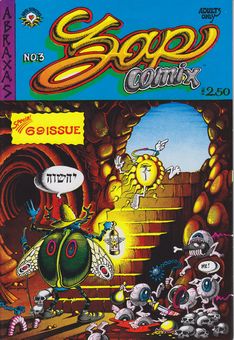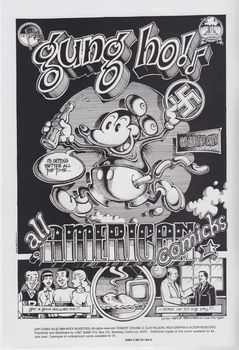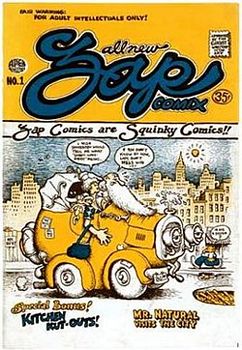Zap comix no 3
| série: | Underground (US) |
| dessinateur / scénariste: | Collectif |
| éditeur: | Last Gasp |
| genre: | Porno |
| classement: | carton131 |
| date: | 1969 |
| format: | broché |
| état: | TBE/N |
| valeur: | 10 € |
| critère: | * |
| remarques: | The first issue of Zap Comix was sold on the streets of Haight-Ashbury out of a baby stroller pushed by Crumb's wife Dana on the first day, there were about 15 issues from 1968 to 1983, but, due to its unusual outside position in the comic distribution industry, a completely accurate count of Zap's circulation cannot be known, hoever overall sales for the comic's first 16 issues are in the millions! while the origin of the spelling "comix" is a subject of some dispute, it was popularized by its appearance in the title of the first issues of Zap design critic Steven Heller claims that the term "comix" refers to the traditional comic book style of Zap, and its mixture of dirty jokes and storylines Zap Comix No. 3 special issue 1969 a mixture of various stories by artists - Crumb (hairy) - Moscoso (Camel) - Clay-Wilson (come fix) - Shelton (the wonder wart-hog) - Crumb (street corner) - Clay-Wilson (captain Pissgums and his pervert pirats) - Crumb (dirty dog) - unknown (atomic comics) >> the perfect sample of an underground comix serie Information Zap Comix is an underground comix series which was originally part of the youth counterculture of the late 1960s while a few small-circulation self-published satirical comic books had been printed prior to this, Zap became the model for the "comix" movement that snowballed after its release Premiering in early 1968 as a showcase for the work of Robert Crumb, Zap was unlike any comic book sensibility that had been seen before, after the success of the first issue, Crumb opened the pages of Zap to several other artists, including S. Clay Wilson, Robert Williams, "Spain" Rodriguez, Gilbert Shelton, and two artists with reputations as psychedelic poster designers: Victor Moscoso and Rick Griffin, this stable of artists, along with Crumb, remained mostly constant throughout the history of Zap Zap #1 was published in San Francisco in early 1968, some 3,500 copies were printed by Beat writer Charles Plymell who arranged with publisher Don Donahue for Zap to be the first title put out under Donahue's Apex Novelties imprint. the contents of the first Zap were not intended to be the debut issue, Philadelphia publisher Brian Zahn (who had published earlier works of R. Crumb in his Philadelphia-based underground newspaper Yarrowstalks) had intended to publish an earlier version of the comic, but reportedly left the country with the artwork (?) rather than repeat himself, Crumb drew a new assortment of strips, which replaced the missing issue in late 1968, shortly before Zap #3 was to be published, Crumb found Xerox copies of the missing pages from the original Zap #1, which (according to fellow Zap contributor Victor Moscoso) successfully captured the linework but not the solid blacks, after being re-inked by Crumb, those strips subsequently appeared as Zap #0, thus Zap #0 became the third in the series (even though it was drawn before #1 in 1967) and Zap #3 the fourth with issue #4 (Aug. 1969), Zap moved publishers to the Print Mint, which unfortunately weathered a lawsuit related to its contents a 1973 U.S. Supreme Court ruling led to the collapse of the underground comix market and after that Zap was published sporadically, with it being typical for three to five years to pass between new issues, Zap continued to be published by Print Mint through issue #9 (1978), when the company stopped publishing comics altogether. from issue #10 (1982) onward, Zap was published by Last Gasp (which also published many reprints of earlier issues), again, there were often long periods between issues: altogether, five issues of Zap were published (by Print Mint and Last Gasp) in the 1970s, three issues in the 1980s, and two issues in the 1990s, Zap #15 came out in 2005, seven years after the previous issue. issues #13–15 all featured cameos by sex-positive feminist Susie Bright as a character within its pages (or on the cover) |
| couvertures: |     |
Copyright 2008 - 2025 G. Rudolf
